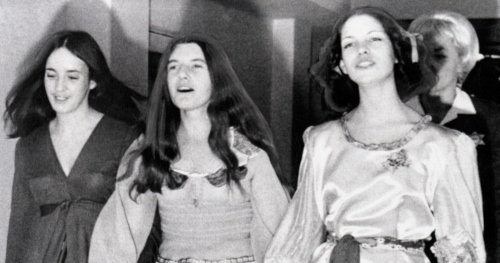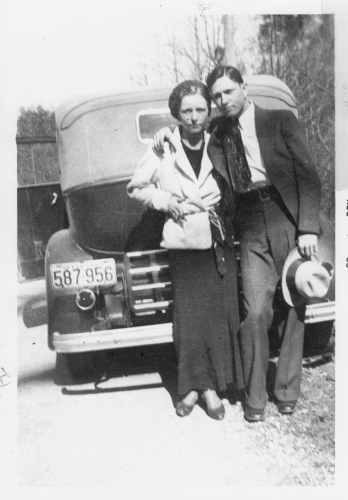“Hybristophilia is a phenomenon, where individuals, often women, develop strong affectionate or romantic feelings towards individuals incarcerated for serious crimes [or notorious for] criminal behaviour.
“[…] Initially defined within a sexual context, recent explorations reveal that the attraction often transcends sexual desire. Experts highlight the role of psychological factors like thrill-seeking and a desire to nurture or reform. The influence of media in romanticising criminals is also noted…”

Leslie Van Houten, Susan Atkins and Patricia Krenwinkel were among the “Manson family” members convicted of murdering nine persons under the influence of criminal Charles Manson.
The following Letter to the Editor on hybristophilia was submitted to Wired868 by Dr Russell Lutchman, consultant forensic psychiatrist, Birmingham, UK:
Hybristophilia is a phenomenon, where individuals, often women, develop strong affectionate or romantic feelings towards individuals incarcerated for serious crimes.
It is a complex and multifaceted psychological condition that has garnered interest within both psychiatric and criminological domains.

The concept of hybristophilia, initially defined by Dr John Money in 1986, began as a term encapsulating a sexual attraction towards individuals who have committed serious crimes.
It is essential to note that the understanding of hybristophilia has evolved and can vary. Some interpretations may emphasise the attraction to incarcerated individuals, while others may focus on the fascination with criminal behaviour or the associated notoriety.
In essence, while a common aspect of hybristophilia involves an attraction to inmates, the concept itself can be multifaceted and may encompass various forms of attraction to individuals with a history of serious criminal activity.
This correspondence is for educational purposes only. It alludes to no known or named individual, in the public or other domain. It may assist some women who are in danger, unknowingly to themselves.
Initially defined within a sexual context, recent explorations reveal that the attraction often transcends sexual desire. Experts highlight the role of psychological factors like thrill-seeking and a desire to nurture or reform.

The influence of media in romanticising criminals is also noted. However, there is a consensus on the need for more empirical research to understand its nuances fully, as much of the current understanding is based on theoretical frameworks and anecdotal evidence.
The concept has faced criticism for its broad and ambiguous definition. Some experts argue that the term may pathologise normal variations of human attraction, while others question the empirical evidence supporting its classification as a paraphilia.
Additionally, the overemphasis on sexual attraction in earlier definitions is critiqued for overlooking the complex emotional and psychological aspects involved. This has led to calls for a more nuanced understanding and careful application of the term in both clinical and forensic contexts.

Bundy kidnapped, raped and murdered dozens of young women and girls, performed sex attacks on their corpses and kept severed heads at his apartment as mementos.
Yet even after his confession, he continued to receive mail from female fans and got married while awaiting his execution.
(AP Photo/Pool)
The term fell casually into what is known as paraphilia, as conceptualised in the DSM-5 diagnostic manual. However, it was not listed in DSM-5 as a paraphilia.
Extreme caution should be exercised not to force the phenomenon to become a mental disorder when there is inadequate fit into diagnostic criteria. For example, narcissism is not simply to become narcissistic personality disorder.
The term has some observational validity but lacks construct validity from empirical research.

Epidemiological studies on hybristophilia are scarce to non-existent, and the research available often focuses on broader aspects of criminal attraction and behaviour, rather than specifically on hybristophilia.
For instance, studies have explored the characteristics of female serial killers, the dynamics of mixed-sex partnered homicide, and the general fascination with true crime, particularly among women.
These studies provide insights into the motivations and psychological profiles of individuals who commit crimes and those attracted to them, but they do not directly address hybristophilia in an epidemiological context.

The pair were wanted for a string of robberies and were believed to have murdered at least nine police officers and four civilians before they were killed in a shootout with police.
Bonnie was 23 and Clyde was 25.
The lack of specific epidemiological studies on hybristophilia reflects the complexity and rarity of this phenomenon, as well as the challenges in researching such a niche area within psychological and criminal studies.
Hybristophilia, as currently broadly conceptualised, harbours inherent dangers. Primarily, it can lead to unhealthy or dangerous relationships, as the attraction is often towards individuals with a history of violence or criminality.
There’s a risk of emotional manipulation and abuse, especially in situations where the incarcerated individual might exploit the affections of the hybristophiliac for personal gain.

Additionally, this attraction can result in social stigma and isolation for the individual experiencing it, as society often views such attractions negatively. Psychologically, it may also reflect deeper unresolved issues or trauma, necessitating professional intervention.
The concept of hybristophilia as evolved from being narrowly defined as a sexual attraction to criminals, to a broader understanding encompassing various emotional and psychological aspects.
Any classification or formal diagnosis of hybristophilia is inappropriate because the term does not have a recognised place within the DSM-5 nor any established diagnostic criteria. This lack of official classification raises concerns about the risks of pathologising potentially normal variations of human attraction.

Nonetheless, the phenomenon poses dangers, including unhealthy relationships and emotional manipulation—particularly for women who may find themselves drawn to individuals with criminal backgrounds.
It is crucial to approach such attractions with caution and awareness, recognising the potential risks while also understanding the complex psychological underpinnings that drive these attractions.
Want to share your thoughts with Wired868? Email us at editor@wired868.com.
Please keep your letter between 300 to 600 words and be sure to read it over first for typos and punctuation.
We don’t publish anonymously unless there is a good reason, such as an obvious threat of harassment or job loss.
 Wired868 Wired868 for smart sport news and opinion
Wired868 Wired868 for smart sport news and opinion







Mr Editor, May I make so bold as to inquire who’s the intended audience here? Asking for a female prison officer friend. And her husband.
We ent call no fowl… 😉